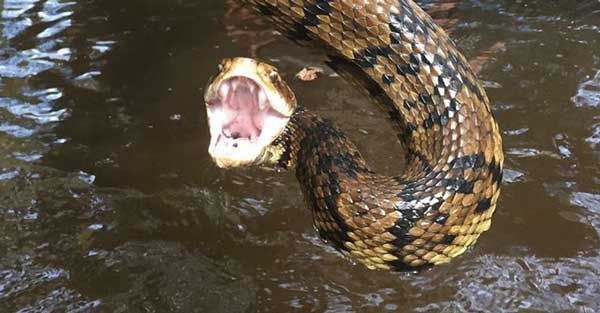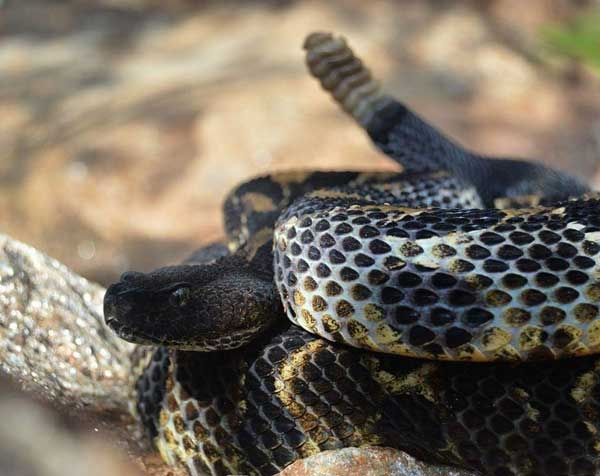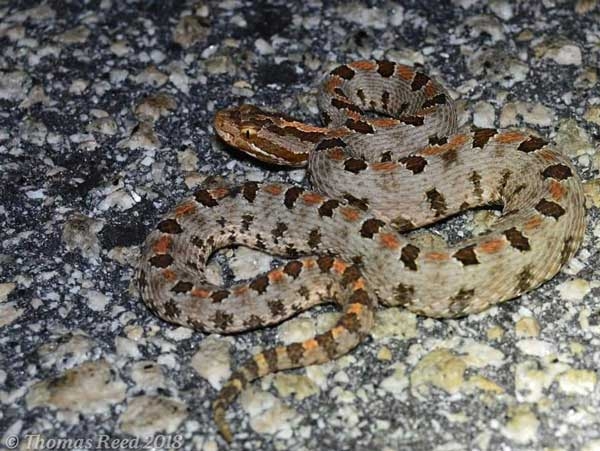Copperhead
Copperheads can reach 48 inches in length. They are the most common venomous snake in the state and occur across North Carolina, except for the Outer Banks. Dorsally, copperheads have keeled scales. Their base color is brown, grayish brown, tan, or pinkish with dark-brown, hourglass-shaped cross bands that are light in the center. From the side, these bands look like Hershey’s Kisses. The pupils of the copperhead are elliptical, and they have a pit on each side of the head between the eye and the nostrils. Ventrally, copperheads have dark-brown blotches on the edges of the scales running the length of the body. Juveniles usually have greenish-yellow or yellow tail tips. Copperheads can be active during the day or night. They can be located under cover objects and are not aggressive. Copperheads are live-bearing and feed on amphibians, reptiles, birds, small mammals, and large insects. When encountered, they usually try to escape but may attempt to bite if stepped on, cornered, or restrained. Copperhead venom is rarely fatal, but bites require immediate medical attention. If you encounter this species, leave it alone!
Cottonmouth
The cottonmouth (sometimes called water moccasin) can reach a length of 71 inches and occurs in the coastal plain and sandhills of North Carolina. Dorsally, they have keeled scales and an olive or brown base. They usually have tight black cross bands with light centers extending the length of the body. They may occasionally be uniformly dark with no obvious cross bands. Cottonmouths have elliptical pupils and a pit between the eyes and nostrils on each side of the head. Ventrally, they have dark blotches down the length of the body. Juveniles usually have bolder, more chestnut-brown dorsal patterns and yellow tail tips. Cottonmouths can be active night or day and are semiaquatic and are usually located near wetlands. They are live-bearing and feed on fish, reptiles, amphibians, birds, and small mammals.
Cottonmouths usually flee when encountered, but may coil, rear up, and gape the mouth. If cornered, stepped on, or antagonized, cottonmouths will readily bite. Bites are rarely fatal but require immediate medical attention. If you encounter this species, leave it alone!
Eastern Diamondback Rattlesnake—Venomous
(Crotalus adamanteus)—Endangered in North Carolina
One of the largest snakes in North Carolina, the eastern diamondback rattlesnake can reach 78 inches in length. This rare snake occurs only in the southeastern corner of North Carolina. Dorsally, they have keeled scales with an olive or dark-brown base. Eastern diamondbacks have dark, diamond-shaped blotches with light centers and yellow bordering; their heads feature black bars with yellow bordering on each side running from the eyes to the corners of the mouth. Ventrally, they are yellowish. The scales at the end of this snake’s tail form a rattle used to warn away potential predators. Eastern diamondback rattlesnakes are active primarily during the day and can be located in stump holes, under cover objects, or in burrows. Eastern diamondbacks are live-bearing and feed on rabbits, mice, and other small mammals. They usually coil up and rattle their tails when encountered; if antagonized, they will bite. The bite of an eastern diamondback rattlesnake is very dangerous and requires emergency medical attention. Eastern diamondbacks are endangered in North Carolina; if you encounter this species, leave it alone!
Timber Rattlesnakes—Venomous
(Crotalus horridus)—Special Concern in North Carolina
Timber rattlesnakes can reach a length of 72 inches. These rattlesnakes once occurred statewide, but have been extirpated from many portions of the piedmont. Dorsally, the scales are keeled and vary in color across their range. They have a segmented rattle composed of shed tail scales on the end of their tail. In the mountains, timber rattlesnakes have a base dorsal color of yellowish or black, while in the rest of the state (where they are often referred to as “canebrake rattlesnakes”), the base is brown, gray, or pinkish. This species has a dorsal pattern of dark blotches and wavy, chevron-shaped cross bands. The canebrake color phase has a reddish or brown mid-dorsal stripe and an orange or dark-brown bar on the face from the eye to the corner of the mouth. Ventrally, these snakes are whitish or yellowish with black stippling or mottling. Like all pit vipers, they have a pit on each side of the head, between the eye and nostrils. Timber rattlesnakes are active day and night. Their habitats include rocky outcroppings and fields near wetlands or forests. They frequently use stump holes and cover objects. Timber rattlesnakes are live-bearing and feed primarily on small mammals and birds. When encountered, they usually try to avoid being noticed or to escape. If cornered, captured, or antagonized, timber rattlesnakes will rattle their tails and strike. Bites from timber rattlesnakes should receive immediate medical attention. Timber rattlesnakes are a species of special concern in North Carolina; if you encounter this species, leave it alone!
Pigmy Rattlesnake—Venomous
(Sistrurus miliarius)—Special Concern in North Carolina
Pigmy rattlesnakes reach a length of 26 inches and occur primarily in the eastern and southeastern coastal plain and sandhills of North Carolina. Dorsally, the scales are keeled with a base of gray to red with dark-brown or black spots; some have a reddish stripe down the length of the body. Near the Albemarle Peninsula, individuals have glossy red, orange, or pink patterns. This species has long, black or dark-brown spots on the top and sides of the head in addition to a small pit between the eye and nostrils on each side. Ventrally, they are white or pinkish with dark spots. Juveniles have white or yellow tail tips. Pigmy rattlesnakes have small rattles on the tips of their tails. Active day or night, they are sometimes located near cypress ponds or other bodies of water when they are not under logs or other cover objects. They are live-bearing and feed on small snakes, frogs, lizards, large arthropods, and small mammals. When cornered, captured, or antagonized, this species will rattle its tail and strike. Pigmy rattlesnakes are one of the less venomous species in the state, but their bites still require immediate medical attention. Pigmy rattlesnakes are a species of special concern in North Carolina; if you encounter this species, leave it alone!
Publication date: Aug. 21, 2019
Reviewed/Revised: July 12, 2024
AG-472-02
Other Publications in Snakes
- Snakes: Family Colubridae
- Snakes: Family Elapidae
- Snakes: Family Viperidae
N.C. Cooperative Extension prohibits discrimination and harassment regardless of age, color, disability, family and marital status, gender identity, national origin, political beliefs, race, religion, sex (including pregnancy), sexual orientation and veteran status.





